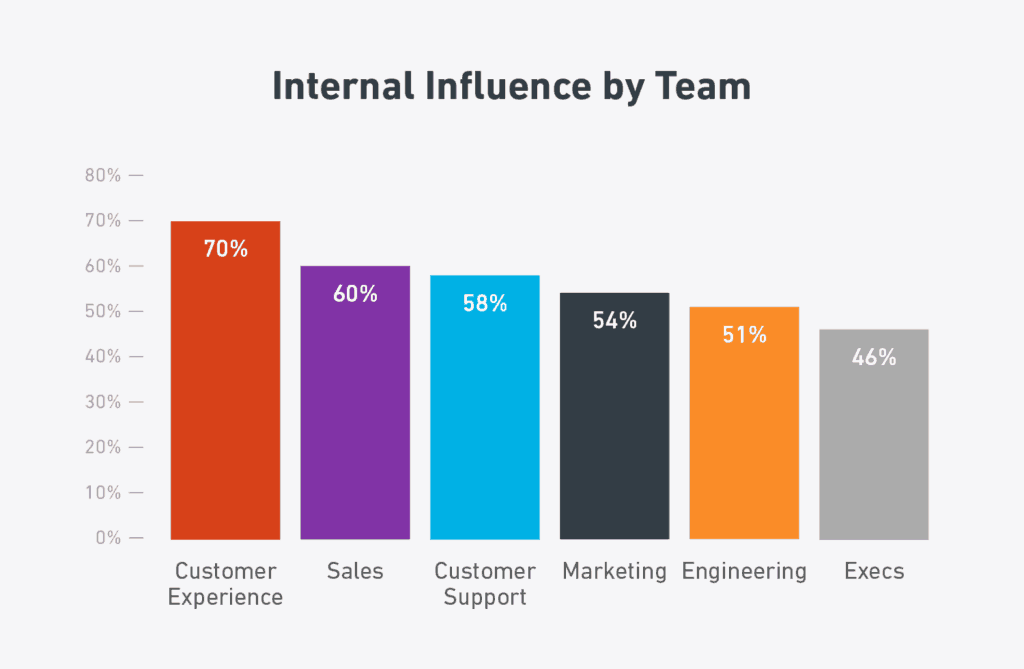The Recipe for a Balanced Feedback Diet

As the cliche goes, “the customer is always right.” Unfortunately, most customers can’t agree on what exactly they want. Today’s customer profile most likely doesn’t encompass everyone you plan to serve a couple years from now. And, oh, yeah, customers aren’t exactly concerned about whether your company is making money, as long as you’re meeting their needs.That’s why customer feedback is only one ingredient in your product strategy and planning process. You need to take in inputs from a variety of stakeholders, triage it, and then, finally, present a prioritized and packaged set of requirements for what your company should actually be making.
Lots of customers, lots of ways to get feedback
When it comes to customer feedback, there are multiple avenues for soliciting and receiving it. In UserVoice’s recent report on The Influence of Feedback on Product Development, customer interviews were ranked the most valuable source of product input from customers, followed by usability tests, surveys, customer advisory boards, and in-app tools.

Of course, the two most popular sources of feedback, customer interviews and usability tests, are the most time consuming, since they are usually conducted one customer at a time. They’re also are the most limited in their quantitative value, due to their one-on-one nature. And while these might provide the most in-depth insights due to the personal nature of the feedback collection, there is an inherent danger in the input from customer interviews and usability tests being too heavily relied upon. You can only interview so many customers and conduct so many usability tests, and small sample sizes can and will skew your analysis. That’s why it’s essential to use other sources that cast a wider net to validate the findings from these more popular methods. For example, if a few customer interviews uncover a previously unknown customer need, you can use a survey of a far larger group of customers and prospects to qualitatively assess the real demand for a new feature before you slot it into your roadmap.On the other hand, in-app feedback is the most scalable of all customer feedback collection methods. It’s basically free to solicit and collect the data and every single user is a potential feedback provider. Organizations with more than 5,000 users find in-app feedback to be the most valuable of all customer sources.This makes sense when you realize that a few customer interviews or usability studies could skew the analysis toward individual preferences instead of the majority of the user base. But in-app feedback collection comes with its own set of challenges - a big one is integrating feedback collection into the user experience in a quick and unobtrusive way to ensure users complete their inputs and don’t view it as an annoyance. We’ve got plenty more to say about this topic if you’re interested.
Consider the source of customer requests
Not all customers are created equal, and when you’re selling B2B, not every customer is necessarily your target user. When collecting, reviewing, and prioritizing customer requests, it’s a good idea to map each individual request back to the persona of who asked for it.“Pause and ask yourself to consider the relationship your product has with the individual passing along the feedback. If they’re intimately involved in some way,” says Mike Belsito of Movable. “It could very well be that this feedback is gold. However, if they’re really not involved much in your product or how it’s used by customers, it’s not unhelpful at all, but it certainly might not have the same weight.”Keeping in mind how “real” any input actually is can save you from pursuing a path that doesn’t add any true value for actual users.
Look beyond just the customer
While customer feedback is essential, there are plenty of worthwhile opinions within your own organization. There are at least six distinct sources of internal stakeholder feedback and most companies listen to all of them in regards to what gets put on their roadmaps.

Customer experience leads the pack, as 70% of organizations take their feedback into account when roadmapping, That’s followed in descending order by sales (60%), customer support (58%), marketing (54%), engineering (51%) and executives (46%).Every product roadmapping cycle should include a review of requests and product feedback from internal stakeholders, followed another review session of the proposed roadmap with stakeholders to make sure there are no surprises when their pet feature doesn’t make the cut.
Data collection and analysis
While people—be they customers or internal stakeholders—are an invaluable and irreplaceable source of product input, your product itself can also serve as a treasure trove of trendspotting and problem identification. Whether that means using Google Analytics to unearth nuggets of wisdom from user flows and click paths on web apps, or the reports you’re generating from product data, there’s unlimited potential to mine some insights without talking to another human being.“If you consistently observe a certain behavior from your users, react to it,” says Megan Bannister of Zapier. “It’s a valuable type of customer feedback.”While no one recommends that your product decisions be all purely data-driven, it’s a huge asset that is often either untapped completely or not fully exploited.
Be social
Although diving into social media updates regarding your product can be a major time suck, social media is a worthwhile ingredient to consider. The focus shouldn’t be on individual tweets and posts, but rather on the larger trends. Since it’s a public forum versus a direct support channel, people are more likely to only post when they’re feeling passionate (good or bad) about your product.“Social listening doesn’t just have to focus on surfacing the negative,” says Kristian Bannister of Brandwatch, “We can also gain valuable feedback about what our customers like about our product or how they are using them day-to-day.”You’ll want to use topic clouds, sentiment analysis and conversation segmenting to make any actual sense from large volumes of chatter, but it’s worthwhile listening to what people say when no one has asked them anything.
Monitor the competition
We all know copycat tactics and innovation aren’t exactly synonymous, but you’d be a fool not to pay attention to what your competitors are up to and take that into account when weighing your options for future releases.While many companies don’t like to admit it, everyone’s trying to keep up with the pack’s baseline while forging ahead with their own unique features and innovations. For example, when Instagram launched its Stories feature, Instagram’s CEO fully acknowledged that that Snapchat “deserved all the credit.”You don’t necessarily have to go quite that far, but if you see your competitor is now doing something that you think your users would also want, you shouldn’t NOT do it just because they did it first.
Validating feedback across multiple sources
Collecting input from so many places gives product managers an opportunity to see if what they’re hearing rings true across the spectrum of customers, prospects, internal stakeholders and competitors.For example, if you have an internal stakeholder jumping up and down that you MUST include this feature, but you’re not hearing any customers asking for it and you’re not seeing it show up in your competitor’s products, you may want to investigate a little further or push back on the person asking for it. Using the lack of customer requests as your defense, you can challenge the request without making it personal.On the flip side, when you’re hearing requests from customers but no one is talking about that issue internally, it’s an opportunity to ask internal stakeholders what they think and see why it’s not already on their radar. While plenty of innovations come straight from the minds and mouths of customers, they should also make sense for the business.
Pulling it together with themes
With so much input from so many sources, it is easy to get lost in the details and lose sight of the big picture. As you wade through what you’ve collected, you can begin coding and categorizing the feedback you’re receiving into themes. This has nothing to do with what you might build or when it might be released, but rather overall trends in what you’re seeing.Looking at the individual requests, complaints and inputs around a particular theme provides context and quantitative ammunition for justifying an investment in this area.
Closing the loop
While collecting feedback can take up more than 12 hours per week of a product manager’s time, closing the loop isn’t always a priority. In fact, only 35% of organizations always make that final step when it comes to customer and stakeholder feedback.Although everyone’s busy, providing an update on where a request ended up is an essential ingredient of any customer-centric organization, which has knock-on effects when it comes to customer loyalty, satisfaction and their likelihood to recommend your solution to others.So don’t skip to dessert without eating your vegetables and letting people know the good or bad news regarding where their request ended up in the queue (or if it didn’t get in there at all).
So, what’s the perfect combination?
The ideal recipe for collecting feedback is to ensure you have a variety of sources. Just like we shouldn’t eat the same food all the time no matter how healthy it may be, we don’t want to over rely on one or two feedback collection methods.Every cycle should include a helping of both quantitative and qualitative customer feedback, such as a survey AND a set of customer interviews or in-app feedback collection AND a usability test. The quantitative items will spot trends while the qualitative methods will provide context and deeper insight into user behavior.You should think about what was most important to internal stakeholders, particularly what issues were causing support pain, what could help sales close more deals and what could positively impact revenue.Insights gleaned from product data and social media should add some flavor—and justification—for what you have planned. And of course, you should always see what they’re eating at the next table to decide if “I’ll have what she’s having” is the right move.Variety is the spice of life. Not too much of any one thing. And don’t forget to eat your vegetables… which is our nickname for technical debt.

